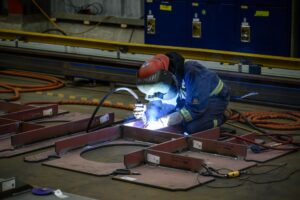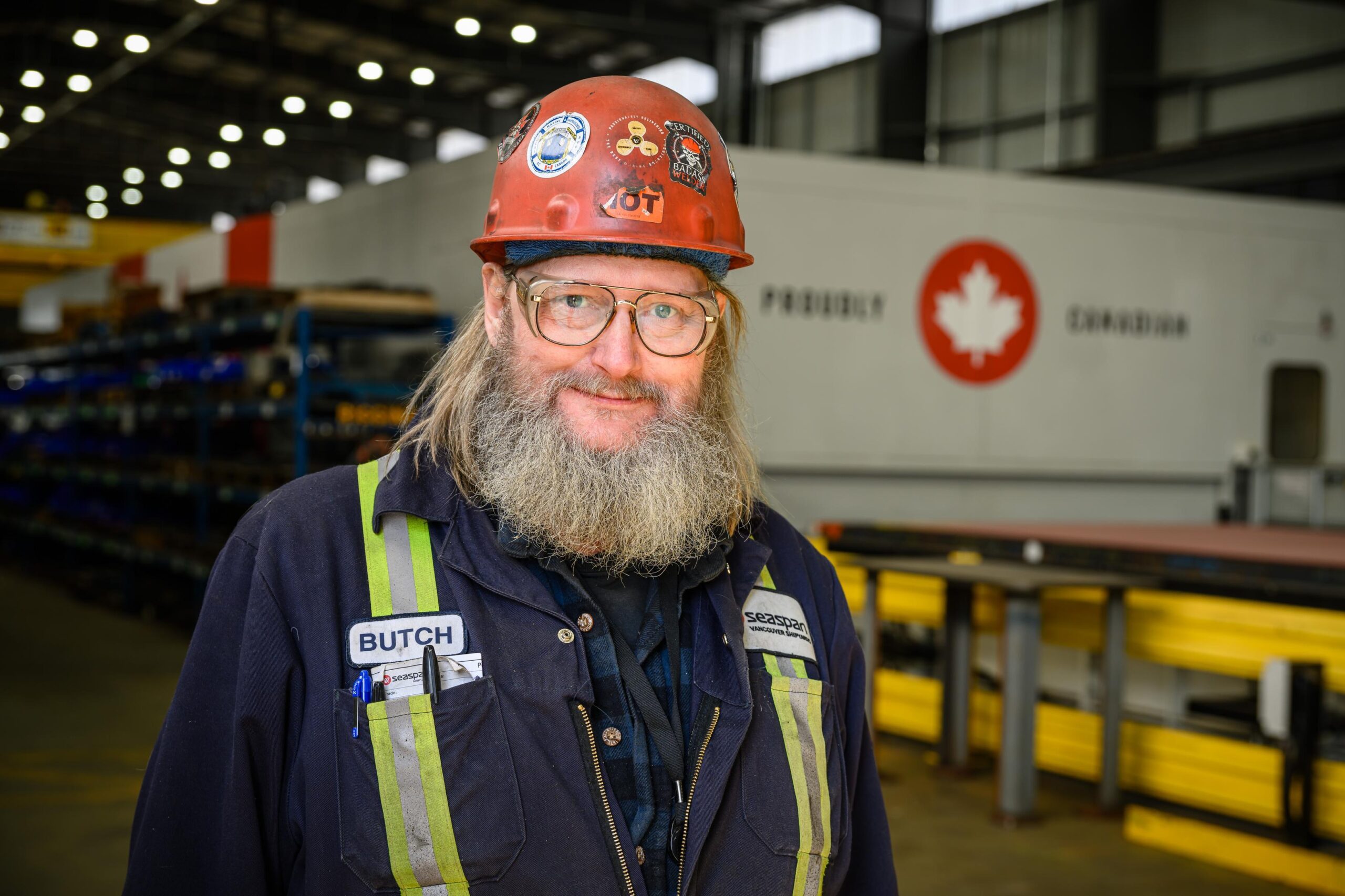“This new Polar project is everything, it’s more complex than anything we’ve done before, but we’ve got the talent. It’s giving the younger generation a chance to learn, to build something meaningful — and to build a life.”
“I started at Seaspan on June 22, 1978.”
For nearly five decades, Butch Sidey has been part of the shipbuilding community at Seaspan. He joined the company in 1978 as an Improver — an entry-level role for welders at the time — and has spent his career helping build vessels of all types, from ferries and barges to specialized ships like icebreakers.
His path to welding started in high school. He transferred from North Van High to Carson Graham Secondary for its trades program, with a plan to become a mechanic. That changed after one welding class. “After that first course, I said, ‘This is for me.’ And I never looked back.”
Today, Butch works mainly at the south end of SOC 30 which is also called the forming shop, at Seaspan’s Vancouver Shipyards. He’s currently welding structural parts for Canada’s new Polar Icebreaker, the flagship of the Canadian Coast Guard’s future Arctic fleet.
“We’re welding smaller pieces right now — things like flat bars joined to plate,” he explains. “Each one might be four feet by six feet, but it’s all part of the bigger picture.”

Butch and others attend the first cut of steel on the Polar Icebreaker at Vancouver Shipyards
For Butch, this project brings his career full circle. In the early 1980s, he contributed to the construction of Miscaroo, an offshore support vessel with icebreaking capability launched in 1983. While he wasn’t yet welding major seams at that stage in his career, he remembers the unique challenges of working on an ice-strengthened hull. “Icebreakers are reinforced with extra framing for strength, so space gets tight — there’s a lot of confined areas,” he says. “It’s demanding work and the steel is thicker, up to 60 mm in some areas to be strong enough to cut through ice.”
He also notes how much the work environment has changed since those early days. “When I started, we didn’t always have the PPE we do nowadays like respirators or ear plugs — it was a different time. The improvements in safety over the years have been significant.”

A Seaspan employee works on Polar Icebreaker Steel
Since then, he’s seen the yard go through many changes, from the fast cat ferry projects in the 1990s to the construction of barges and the start of the National Shipbuilding Strategy. He takes pride in the quality of the work done over the years. “We had great welds that passed all the tests, and I think that helped us earn the trust to take on more complex builds and ultimately win those NSS contracts.”
There have been lighter moments too — like when he cut the legs off a school chair and used it to sit beneath a barge while welding overhead, day after day. “Now it’s more ergonomic,” he laughs. “But back then, I lived to weld. I didn’t weld to live.”
Even now, with two new knees and decades of wear behind him, Butch is still at the bench, still welding. “The work itself hasn’t changed. My favourite part of the job hasn’t changed. It’s welding. And I’ve got the scars to prove it.”
As Butch continues to contribute in a meaningful way, he also sees the impact long-term shipbuilding projects like the Joint Support Ships, Offshore Oceanographic Science Vessel, and now the Polar Icebreaker are having on younger tradespeople. “They’re learning a lot, getting their hours in, and building a future. The work is steady, and so they’re able to plan for the future instead of scrambling between layoffs.”
One positive change he’s especially proud of is the growing number of women working in the trades. “There were hardly any women welders 30 years ago. Today, they’re out here doing the work, and they’re proud of it — and they should be. Welding is for anyone who’s willing to put the work in.”
Looking back on his career, Butch says the most rewarding part has been the people. “I’ve worked with every trade here over the years. And that’s been a really good part of it, the people.”
Outside of work, Butch enjoys spending time with his family, especially his grandchildren. But even after more than 45 years on the job, he still finds satisfaction in the work. “I’ve always enjoyed welding,” he says. “That part hasn’t changed.”
As construction ramps up on the Polar Icebreaker, Butch’s steady hands and deep experience remain an important part of the process — connecting Seaspan’s history with its future, one weld at a time.
